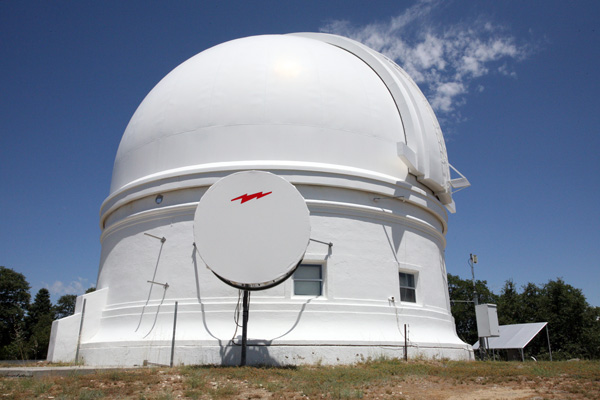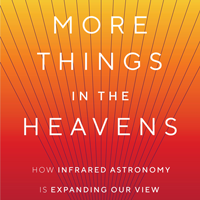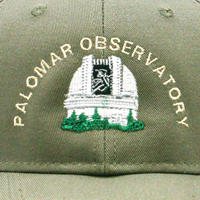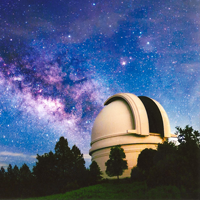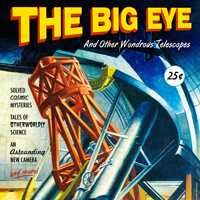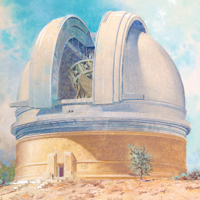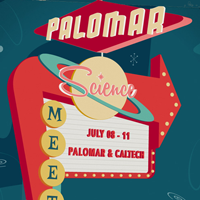Friends of Palomar Observatory Website
Upcoming Events

The Newsletter of the Friends of Palomar Observatory, Vol. 11 No. 1 – April 2016
Planet 9 From Outer Space
By Steve Flanders
Caltech astrophysicist Konstantin Batygin explains to Chris Lintott why they think there may be an elusive ninth planet in the Solar System. 12 February 2016. Duration: 4 minutes. (© BBC)
On January 20 of this year, Caltech astronomer Mike Brown and Caltech astrophysicist Konstantin Batygin announced that they had evidence pointing to the existence of a massive but unseen planet lying well beyond the orbit of Neptune. Their alleged planet was dubbed “Planet 9,” a label that alludes to the similarly unseen object known as Planet X that Clyde Tombaugh and others had searched for early in the last century.
This label also recalls the fact that the Solar System once contained nine planets. Indeed a decade ago, Mike Brown had a hand in demoting Pluto. Now, under this nickname, he may be intent on restoring the Solar System's population count to what it was before he discovered the dwarf planet Eris and upset the existing order of things.
The task of restoring that population count is complex and will require among other things that someone actually photographs and measures Planet 9. For the moment, Brown and Batygin have created mathematical models using data from their observations. With these models, they predict that Planet 9 has a mass 10 times that of Earth’s and requires 10,000 to 20,000 years to complete one orbit.
Planet 9, they argue, moves in a highly elliptical orbit that at perihelion brings it no closer to the Sun than 200 AU—one astronomical unit being the distance from the Sun to the Earth—and at aphelion brings it out to a point separated from the Sun by perhaps 1,200 AU or 111.5 billion miles. In contrast, Neptune, currently the most remote of the major planets, orbits the Sun at an average distance of 30 AU completing one circuit in 165 years.
At this time, astronomers were discovering objects in the Kuiper Belt having elliptical orbits that extended perhaps 1000 AU from the Sun. If Brown and Batygin’s models turned out to be correct, Planet 9 might be by far the most distant object in the Solar System.
Even so, these models give only a vague suggestion of where in the sky Planet 9 might be located. Expected to be no brighter than magnitude −22 at best and with little day-to-day movement across the sky, this object will be found and photographed with some difficulty.

Poster inspired by the Plan 9 from Outer Space 1959 movie poster. (M. Wong)
As that may be, the task of searching and photographing is not likely to begin in earnest until the research community is convinced of the soundness of Brown and Batygin's theory. To recreate a nine-planet Solar System, they must find colleagues willing to invest observing time and money in the search for Planet 9.
Brown and Batygin may, however, already have assembled an impressive if circumstantial body of evidence built upon careful observation and a meticulous use of mathematical modeling techniques. At least a few professionals seem to be convinced and searches are now underway using among others the Subaru Telescope at Mauna Kea.
What, then, are the arguments being presented by Brown and Batygin? What is their evidence? Why do they believe that Planet 9 is out there?
In their various lines of evidence, Brown and Batygin draw upon the phenomenon of "clustering." In brief, a cluster represents a subset of objects drawn from a larger population because they posses one or more unique distinguishing characteristics. For these two researchers, the general population or domain of the study comprises all of the icy bodies that orbit the Sun in the Kuiper Belt beyond Neptune. And from this domain they have a identified a special subset of six Kuiper Belt Objects (KBOs). The orbits of the members of this subcluster are dramatically different from the orbits that are typical of objects in the general population of KBOs.
Brown and Batygin assert that the particular alignments and other shared orbital attributes of these six KBOs could not have come about by chance. Rather, this configuration must be caused and this cluster, they continue, must have come into being over time as the gravitational force exerted by a massive and more distant planet gradually shepherded these six into the distinctive and highly elongated orbits we now see.
These six objects have been identified through a series of ever finer sequential refinements that starts with a larger cluster consisting of KBOs having orbits with several unique attributes.
The chain of evidence begins with the discovery some time ago of a number of KBOs that orbit at an average distance of 150 AU or more from the Sun and that never come closer to the Sun than 50 AU. All of these objects share two unique dynamical properties. First, all have perihelia—the point in their orbits at which they are closest to the Sun—that cluster around the ecliptic. Second, all are seen moving south to north as they cross to the north side of the ecliptic, the orbital plane occupied by all the major planets of the Solar System.
The phenomenon of clustered of perihelia is not observed among other objects in the Solar System. Moreover, unless some unseen force is at work, we ought to observe these objects crossing the ecliptic in both directions. There must be a gravitational force at work differentially selecting south to north motion to exclusion of movement in the opposite direction.
In 2012, Chadwick Trujillo (Gemini Observatory) and Scott Sheppard (Carnegie Institution for Science) discovered KBO 2012 VP 113. Two years later with the announcement of this discovery, the perihelion of this new object became a matter of discussion. As in the larger cluster already identified, the perihelion of VP 113 is similarly located at the ecliptic. They went on to describe a particular subset of that group made up of twelve extraordinarily distant KBOs that includes both VP 113 and Sedna. Trujillo and Sheppard noted that they had no easy way to explain how these twelve objects came to occupy orbits at such extreme distances. Their conclusion was that only the force of gravity from a massive and more distant planet could have dragged these dozen KBOs to their present locations.
Elaborating upon this work, Brown and Batygin soon after identified a special subcluster of six KBOs taken from Trujillo and Sheppard's group of twelve. These six represent the most distant objects on Trujillo and Sheppard's list. Their six orbits have aphelia lying as much as 1000 AU from the Sun, on the order of 100 billion miles away. And, in addition to having clustered perihelia, their orbits were all found to lie in a plane tilted 30° with respect to the plane of the ecliptic. More remarkably, all six of the orbits of these objects point in the same direction. It is a condition that cannot be sustained. The long axes of these orbits migrate around the Solar System and they travel at different rates of speed. Therefore, some force must be maintaining this alignment.
Researchers have found evidence of a planet with a mass 10 times that of Earth. Jeffrey Brown talks to Mike Brown of the California Institute of Technology. 22 January 2016. Duration: 6:43 minutes. (© PBS NewsHour).
Arriving at this collection of mutually reinforcing indicators, Mike Brown in effect declared victory. The clustering of perihelia, the alignments and tilt of the orbits, the vast distances these KBOs travel away from the Sun—these characteristics, common to the six objects, are entirely at odds with the more or less conventional orbital configurations found in the rest of the Kuiper Belt. With some apparent pride, Brown offers a calculation. These six orbits, he argues, are so similar and so unique that there is only a .007% probability that this alignment could have happened by chance. "This shouldn't happen randomly," he declares, "something must be shaping these orbits."
Or in other words, a massive object we refer to a Planet 9 is real and is out there waiting to be discovered.
Ultimately, the computer models he and Batygin are developing serve to substantiate these conclusions. Over many weeks and months, they have run simulations exploring the role a massive planet might play when introduced into their cluster of six KBOs. Many configurations were tested. Some runs produced results that were encouraging; many others fell far short of the mark. None of the simulations were deemed satisfactory.
Nonetheless, the two scientists continued to experiment until finally they added to the model a massive planet orbiting the Sun in a very particular orbit. However they came to the idea, Brown and Batygin introduced a massive planet in an anti-aligned orbit; that is, an orbit having its perihelion point on the elliptic 180° from the perihelia of all the other objects in the cluster. When they did this, the KBOs in the model assumed the configuration as it is actually observed.
In itself a considerable validation, the model was then pushed further. No longer simply a tool of description and explanation, its simulations also gave testable predictions. Especially, the model predicted that KPOs would be found in orbits running perpendicular to the ecliptic. As it turned out, three other researchers had already seen four unrelated KBOs having just such perpendicular orbits. "We plotted up the positions of those [four] objects and their orbits, and they matched the simulations exactly," Brown commented. "When we found that, my jaw sort of hit the floor."
Of course, there are limits. For all its virtues, Brown and Batygin's model is of little help answering a most essential question: Where in the sky tonight will we find Planet 9? The model's response is categorical. Instead of a specific prediction, it points instead to several vast areas of the sky that might harbor Planet 9.
As well, the model is effectively silent on another point. Where did Planet 9 originate and how did it come to take its place at the extreme outer boundary of the Solar System? These are important questions that may take time to answer. And in any event, the process of finding answers likely will proceed slowly at least until we have found, photographed and measured Michael Brown and Konstantin Batygin's Planet 9.
HPWREN Partners
By Andy Boden
In my recent columns I've written both about exciting new capabilities coming to the Observatory, and how historical contributions of the Observatory tie into modern astrophysics. In this installment from the Director's Office, I'd like to discuss something a little different—to tell you about an enabling technology, and our long-time external partners whose dedication has made much of recent Observatory success possible. I'm referring about our long-term partnership with the High Performance Wireless Research and Education Network (HPWREN) Consortium, and its principals at the University of California San Diego.
Palomar Observatory is located in a geographically remote section of San Diego County. So connecting the Observatory to the modern internet has long been a challenge. Back in 2000, and motivated by their own remote connectivity concerns, UCSD's Hans-Werner Braun and Frank Vernon founded the HPWREN initiative: a network of microwave radio links among sites in rural San Diego County. In its initial development and operation HPWREN was supported by generous grants from the National Science Foundation. Approached by the HPWREN principals, Palomar was quick to be among the first external partners to join the fledgling consortium. It's easy to understand why: Palomar's remote and sparsely populated location was at the time (and continues to be) relatively poorly served by communications infrastructure that so many of us take for granted. Nearly overnight connectivity to the Observatory improved by a rough factor of 100: what was a “T1” (1.5 Mbit/s) internet link serving the Observatory became an “OC3” (155 Mbit/s) microwave data link.
The enhanced network connectivity that HPWREN brought to Palomar was immediately impactful to Palomar science. The Palomar-QUEST survey at the Samuel Oschin Telescope (you know, the one that informed Pluto's “reclassification” to Minor Planet status) was among the first Palomar projects to take advantage of the enhanced network bandwidth provided by the HPWREN, allowing the large imaging datasets to be shared rapidly among the geographically diverse Palomar-QUEST team. However HPWREN as an enabling technology in Palomar science really came into its own with the introduction of the Palomar Transient Factory (PTF) in 2009. The PTF project arc on the Oschin Telescope takes advantage of the bandwidth provided by HPWREN to push the image data off the mountain in near-real-time. This allows near-real-time analysis of imagery at Caltech and elsewhere to detect new “transient” sources the survey is designed to identify. This near-real-time source identification in turn allows for rapid (i.e. same night) follow-up on interesting sources using other telescopes (e.g. 60-inch, Hale). Such rapid source detection and follow-up—a significant factor in PTF success—would simply not be possible without HPWREN. PTF and follow-on projects have been so successful that a large consortium (including the NSF) are developing and deploying the Zwicky Transient Facility (ZTF) at Palomar in 2017.
Today, HPWREN operates as a consortium including research, government, and volunteer organization partners who cooperatively fund and use the network under the continued leadership and custodianship of UCSD. In addition to Frank and Hans-Werner—who are still with HPWREN—we work closely with UCSD staff members Jon Meyer, Jim Hale, and Ron Hawkins. Going forward into the ZTF era, UCSD and Palomar remain committed to supporting our network requirements through HPWREN. Our HPWREN relationship is among the most important and rewarding of Palomar’s institutional partnerships, and one that we deeply appreciate and look forward to continuing for a long time to come.
Season’s Events
On Saturday, May 14 starting at 6:30 pm, Professor Jay Pasachoff of Williams College will be speaking on the subject of “Solar Eclipses, 2016 and 2017 and More.” The talk will be held in the Planetarium at Palomar College in San Marcos.
A veteran eclipse chaser, Professor Pasachoff has probably seen and studied more solar eclipses than anyone else on Earth, by one count, 65 eclipses between 1959 and the end of 2015. He has recently returned from an expedition to study the eclipse seen in Indonesia on March 9.
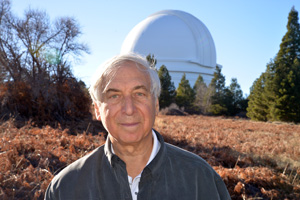
Jay Pasachoff. (J. Pasachoff/Williams College)
During his talk, Professor Pasachoff will tell us about his experience at this March 9 event. He will also discuss the circumstances of and his expectations for the total solar eclipse that will be visible along a narrow band that crosses the United States on August 21, 2017. In addition, he will describe the important science that he obtains by trekking to eclipse sites around the world.
A dedicated teacher and researcher, Professor Pasachoff feels strongly that professional astronomers have important roles to play in educational outreach and in promoting public awareness. In 2003, he received the American Astronomical Society's Education Price “for his devotion to teaching generations of students [and] for sharing with the world the joys of observing eclipses.”
The event at the Planetarium on May 14 will begin with a reception at 6:30 pm. Professor Pasachoff's talk will start at 7:00 pm after which Mark Lane, director of the Planetarium, will present a sky show. Here are directions to the Planetarium. Please park in the lot across the street from the Planetarium. No RSVP is needed and you are welcome to bring guests.
Jay Pasachoff's presentation on May 14 is the first FOPO event of the season. Others are in the planning stage. Our list of proposed activities includes:
- June: An event at the Jet Propulsion Laboratory in Pasadena.
- Late August / Early September: A presentation by a Caltech astronomer and a star party at the Outreach Center.
- October: A presentation at the Outreach Center concerning Native American cosmology.
In addition, we occasionally will be holding afternoon cookouts on weekends at the Outreach Center following the regular public tours. Burgers and hot dogs and salad and popcorn and a movie—last year we had great attendance at these events. All of the members of the Friends of Palomar Observatory are invited to these cookouts and I’ll write to you when we schedule the first one.
- Steve Flanders
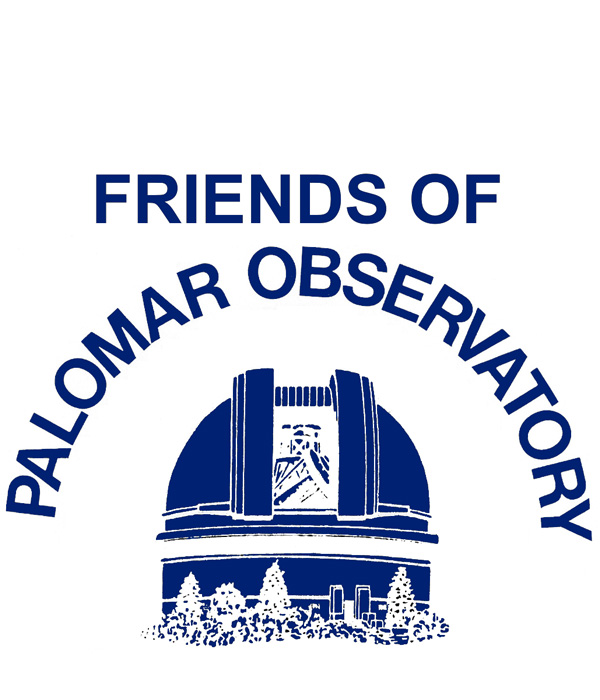
Questions? We've answered many common visiting, media, and academic questions in our public FAQ page.
Please share your feedback on this page at the
COO Feedback portal.
Big Eye 11-1
Last updated: 7 April 2016 SBF/AFB/ACM
